
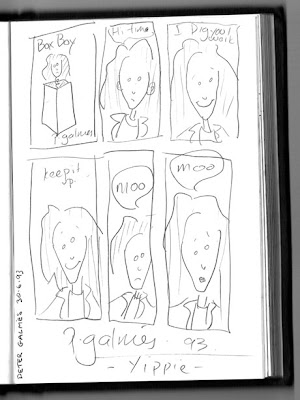

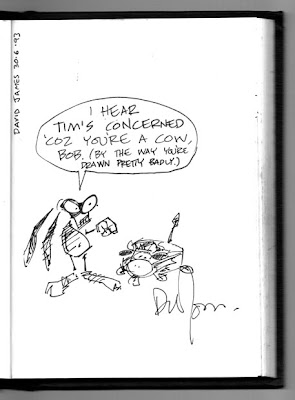
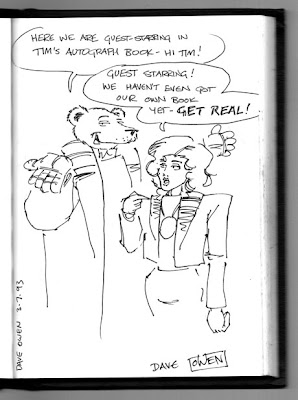

This blog will eventually be used primarily to keep you all up to date with progress on the new Greener Pastures material, but for now it will be full of reviews and other (hopefully interesting) chitchat.







 Cooke's New Frontier is quite a good comic, but it's not as great as it should have been, nor as great as I think everyone wants it to be. I read the two volume collection of this story, and the first volume was very disjointed. The overall impression, especially from this first half of New Frontier, was that Cooke had a great idea, a wonderful love and knowledge of the oeuvre of 40s/50s America and what that felt and looked like, but either didn't have the writing skills, was too lazy, or simply didn't want to, weave a smoothly flowing story from everything he wanted to include in it. Instead, it feels more like a series of character sketches and story ideas for an alternate DC history. In all honesty, I could almost see the change in writing style when Cooke decided to really get the main driving plot more involved with the story. Generally, I think it would have benefitted from a more focussed narrative, possibly from fewer, or even a single, point of view.
Cooke's New Frontier is quite a good comic, but it's not as great as it should have been, nor as great as I think everyone wants it to be. I read the two volume collection of this story, and the first volume was very disjointed. The overall impression, especially from this first half of New Frontier, was that Cooke had a great idea, a wonderful love and knowledge of the oeuvre of 40s/50s America and what that felt and looked like, but either didn't have the writing skills, was too lazy, or simply didn't want to, weave a smoothly flowing story from everything he wanted to include in it. Instead, it feels more like a series of character sketches and story ideas for an alternate DC history. In all honesty, I could almost see the change in writing style when Cooke decided to really get the main driving plot more involved with the story. Generally, I think it would have benefitted from a more focussed narrative, possibly from fewer, or even a single, point of view.  Cooke's page layout choices are interesting. I would estimate that 90% of all pages are approached with the same layout; three wide panels stacked on top of each other. My assumption here is that Cooke was going for a "cinematic" feel with almost every image having a Cinemascope-like presentation. This has it's good and bad points. I think it certainly helps serve the overall feel of the period piece, but surely it gets in the way of pacing. Luckily, Cooke isn't completely slavish to it and decides on several occasions that the pace of the story does indeed require more than three panels on a page or just one panel per tier. Of course, there's also a liberal use of splash pages and double-page spreads.
Cooke's page layout choices are interesting. I would estimate that 90% of all pages are approached with the same layout; three wide panels stacked on top of each other. My assumption here is that Cooke was going for a "cinematic" feel with almost every image having a Cinemascope-like presentation. This has it's good and bad points. I think it certainly helps serve the overall feel of the period piece, but surely it gets in the way of pacing. Luckily, Cooke isn't completely slavish to it and decides on several occasions that the pace of the story does indeed require more than three panels on a page or just one panel per tier. Of course, there's also a liberal use of splash pages and double-page spreads.  Throughout, the characters, while appealing and interesting, aren't really given the time and space to be greatly fleshed out. Cooke is (I hesitate to say "shoehorning" but it may be appropriate) trying to include so many characters into his overall worldview and story, that most of them tend towards one and two dimensional cartoon personalities. Hal Jordan/Green Lantern is the biggest exception to this, and if there was a single character that the book was "about", it would be him. He's certainly the most interesting character in the book, with a nicely realised backstory, origin and first adventure. The Martian Manhunter gets a generous number of pages as well, and as such is also more three dimensional and interesting. To Cooke's credit though, the glimpses he gave me of Superman, Wonder Woman, Batman, and especially The Flash, make me wish I could see much more of his take on all of them.
Throughout, the characters, while appealing and interesting, aren't really given the time and space to be greatly fleshed out. Cooke is (I hesitate to say "shoehorning" but it may be appropriate) trying to include so many characters into his overall worldview and story, that most of them tend towards one and two dimensional cartoon personalities. Hal Jordan/Green Lantern is the biggest exception to this, and if there was a single character that the book was "about", it would be him. He's certainly the most interesting character in the book, with a nicely realised backstory, origin and first adventure. The Martian Manhunter gets a generous number of pages as well, and as such is also more three dimensional and interesting. To Cooke's credit though, the glimpses he gave me of Superman, Wonder Woman, Batman, and especially The Flash, make me wish I could see much more of his take on all of them.  This is definitely a love letter from Cooke to the Silver Age of DC Comics, and as such is lovingly crafted. His fondness for the subject matter is evident throughout the art, writing and research for this 400 page story. I believe it does fall a little disappointingly short of being fully realised, though. That being said, it's still worth picking up for the very interesting take on DC's Silver Age heroes, and the beautiful artwork that presents it.
This is definitely a love letter from Cooke to the Silver Age of DC Comics, and as such is lovingly crafted. His fondness for the subject matter is evident throughout the art, writing and research for this 400 page story. I believe it does fall a little disappointingly short of being fully realised, though. That being said, it's still worth picking up for the very interesting take on DC's Silver Age heroes, and the beautiful artwork that presents it. 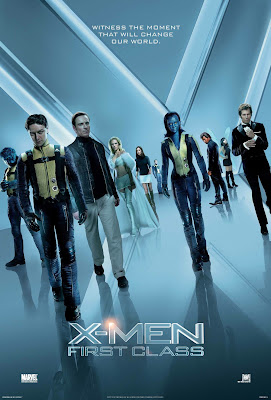

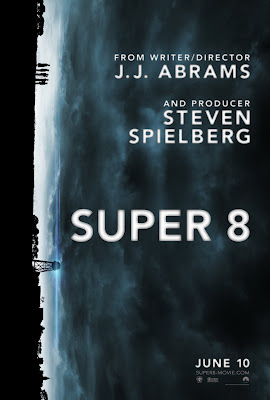

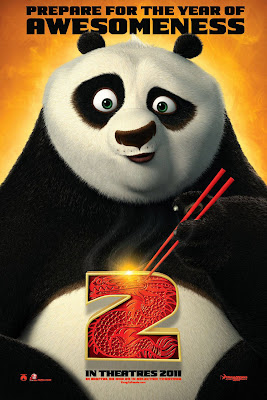
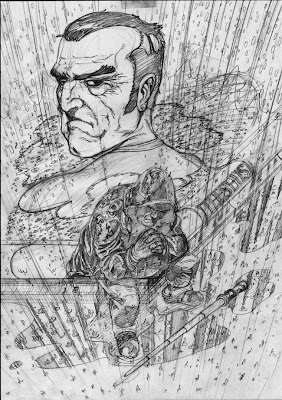 An A3 character study.
An A3 character study. Thor. (at the movies)
Thor. (at the movies) Although it's been a while between updates here, rest assured that we are working on the new Greener Pastures story. I guess at this point I'll let you know that the working title for the project is Greener Pastures: The End, and until we settle on something more concrete and suitable, that's how I'll refer to it here.

So what have we been doing on GP:TE? The photo above answers that: writing, scripting, working out what we're going to do to and with Trevor and his cohorts. That photo shows The five part story as it currently stands in its first draft. I reckon we'll do at least one more draft before I start drawing actual pages and then continue to refine the script as we go from that point on too. This year, 2012, will see a lot of progress I'm sure. Stick around and check in here often to see it happening.